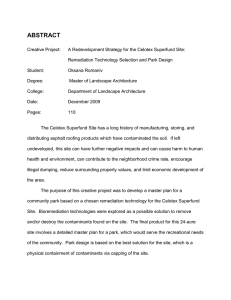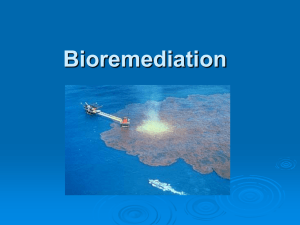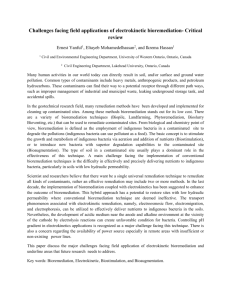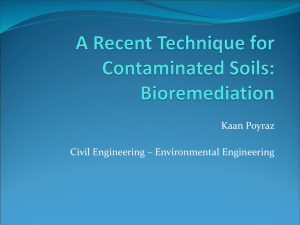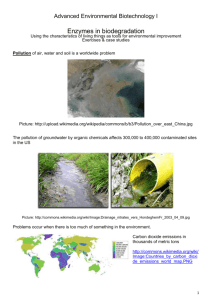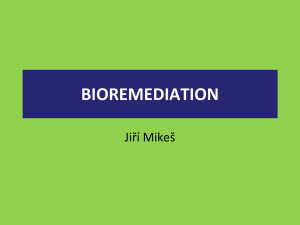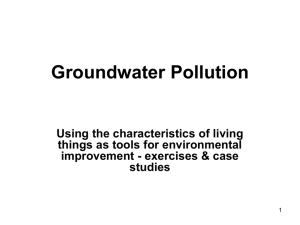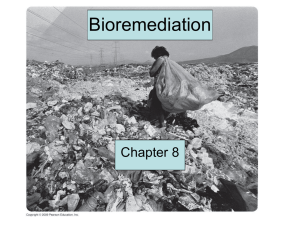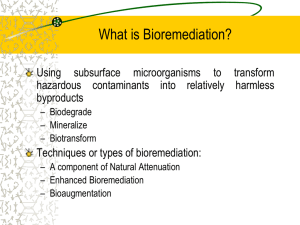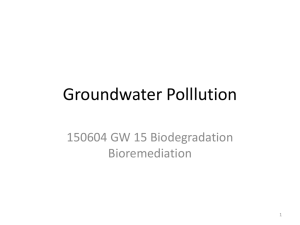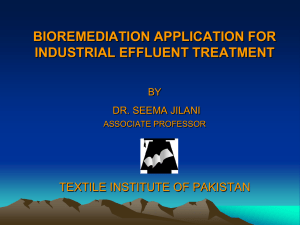An Introduction to Bioremediation
advertisement
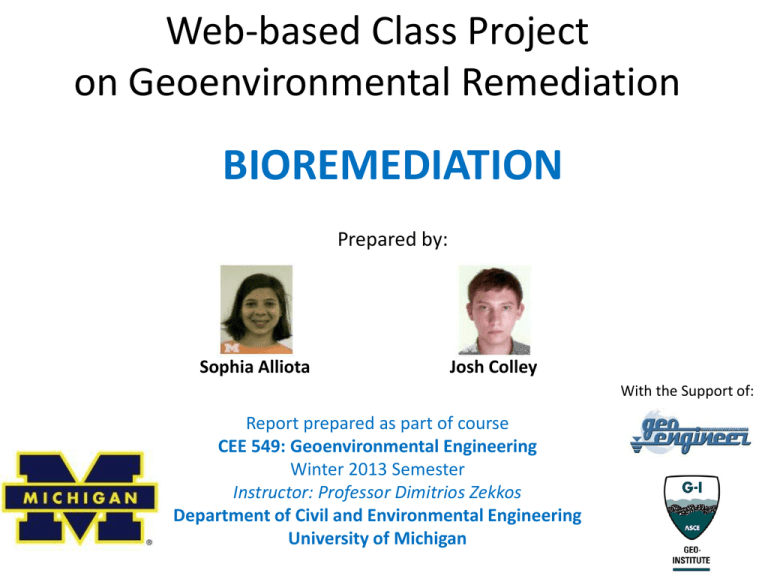
Web-based Class Project on Geoenvironmental Remediation BIOREMEDIATION Prepared by: Sophia Alliota Josh Colley With the Support of: Report prepared as part of course CEE 549: Geoenvironmental Engineering Winter 2013 Semester Instructor: Professor Dimitrios Zekkos Department of Civil and Environmental Engineering University of Michigan What is Bioremediation? • Bioremediation refers to a number of technologies that treat contaminated soil and groundwater by using microorganisms Applicability • To contaminants: – Organic • Excellent for biodegrading organic contaminants e.g. petroleum hydrocarbons, chlorinated and non chlorinated compounds, wood treating agents – Inorganic • Metal sulphides such as those found in Acid Mine Drainage (AMD) can be treated easily using passive anaerobic wetlands • Heavy metals can also be immobilized • To ground conditions: – Soil treatment • Almost all soils can be treated using bioremediation as long as the moisture content is adequate to support microorganisms • Low permeability soils can be hard to treat when trying to permeate amendments through the soil mass – Groundwater treatment • Soils of k=10-4 cm/s or greater are treatable • Again, soils with low k are hard to treat Common Contaminants • Organic contaminants include: – Polycyclic Aromatic Hydrocarbons (PAHs) • E.g. benzene, toluene – Polychlorinated Biphenyls (PCBs) – Pesticides and herbicides – Chlorinated solvents • E.g. perchloroethene, trichloroethene • Inorganic: – Heavy metals – AMD effluent containing metal sulphides Common Sources of Contamination • Underground Storage Tanks (USTs) – Leakage of fuels e.g. petroleum • Wood treating facilities – Preservatives such as creosote common • Arsenals • Chemical manufacturing plants Theory • Fundamentally bioremediation uses microorganisms (e.g. bacteria, yeast and fungi) to break down harmful contaminants • This can be facilitated by using native indigenous microbes or by adding foreign exogenous ones to populate the soil • Different types of microorganisms function well in different conditions: – Oligotrophs function well in low carbon environments – Eutrophs function well in high carbon environments (USEPA, 2012) • Microorganisms can break down contaminants: – Under aerobic (oxygen present) conditions: – Under anaerobic (oxygen not present) conditions: • E.g. fermentation, denitrification • Sulfate reduction in anaerobic wetlands • Conditions must be suitable to promote microbial activity – Temperature 15-45°C – pH ~7 – Moisture content 40-80% of field capacity – Oxygen >2mg/l (aerobic) or <2mg/l (anaerobic) – Nitrogen, Carbon, Phosphorous etc • Conditions can be improved be adding amendments – Oxygen Releasing Compounds, Nitrogen, Phosphorous Flexible methods • Treatment methods can be: – In-situ (i.e. in the ground) • E.g. injection of amendments – Ex-situ (i.e. out of the ground) • E.g. composting, land farming – Aerobic or anaerobic Landfarming (ETec, 2013) • An example of an in-situ aerobic method for treating soil and groundwater (USEPA, 2001) Advantages • Organic contaminants can be broken down into other nontoxic chemicals • Minimal equipment requirements • Can be used in-situ or ex-situ • Can treat wide range of contaminants • Low cost – $30-750 per cubic yard of soil – $33-200 per 1000 gallons of water • Good public perception since ‘natural’ process Disadvantages • Contaminants may only be partially broken down creating toxic by-products • Sensitive to ground conditions • Monitoring to accurately track degradation • In ex-situ processes VOCs need to be controlled Field Setup: In-situ Bioremediation (Tlusty, 1999) Field Setup: Ex-situ Bioremediation (USEPA, 1995a) Field Setup: Land Farming (ETec, 2013) Field Setup: Windrow (Proper, 2013) Case Study: French Limited Superfund Site • French Limited in Crosby, Harris County, Texas (EPA Region 6) was a 25-acre sand mining site from 1950-1965 • The primary contaminants in this waste were benzo(a)pyrene, vinyl chloride, and benzene • In 1987, the EPA decided to try bioremediation, which was the first time that technology was used at a Superfund site Case Study: French Limited Superfund Site (EPA, 1993) Case Study: French Limited Superfund Site • Bioremediation was chosen because it offered a less expensive option to destroy the same amount of waste as an incinerator in the same amount of time • In-situ slurry-phase bioremediation was conducted to remedy the site Case Study: French Limited Superfund Site (EPA, 1993) Case Study: French Limited Superfund Site • Treatment process took 11 months to treat 300,000 tons of soil and sludge • Post-treatment benzene concentrations 7-43 mg/kg • After initial remediation, the French Limited site has been revisited several times to mitigate contamination from floods References • ETec Environmental Technologies LLC (2013). "Landfarming". ETec LLC. http://www.etecllc.com/landfarming-bioremediation.asp (March 13th 2013) • Tlusty, B. (1999) "In Situ Bioremediation of Tricholoroethylene". Resoration and Reclamation Review, Student Online Journal - Department of Horticultural Science, University of Minnesota, Vol 5, Number 2, 1-8. • Proper (2013). "PROPER Gallery - Bioremediation Gallery". Proper. http://proper.menlh.go.id/proper%20baru/html/menu%205/proper%20ga lery/biore%20galery.htm (March 13th 2013). • USEPA. (1993). "Superfund at Work: Hazardous Waste Cleanup Efforts Nationwide". USEPA. • USEPA. (2001a, September). "Use of Bioremediation at Superfund Sites". EPA 542-R-01-019 . • USEPA. (2012, September). "A Citizen's Guide to Bioremediation". EPA 542-F-12-003 . More Information More detailed technical information on this project can be found at: http://www.geoengineer.org/education/web-based-classprojects/geoenvironmental-remediation-technologies
